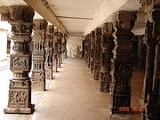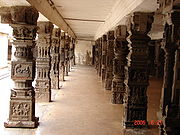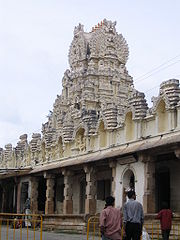
Cheluvanarayana Swamy Temple
Encyclopedia

Melkote
Melukote in Pandavapura taluk of Mandya district, Karnataka, in southern India, is one of the sacred places in Karnataka. The place is also known as Thirunarayanapuram. It is built on rocky hills, known as Yadavagiri or Yadugiri, overlooking the Cauvery valley. Melukote is about 51 km from...
in the Mandya District, Karnataka
Karnataka
Karnataka , the land of the Kannadigas, is a state in South West India. It was created on 1 November 1956, with the passing of the States Reorganisation Act and this day is annually celebrated as Karnataka Rajyotsava...
, India
India
India , officially the Republic of India , is a country in South Asia. It is the seventh-largest country by geographical area, the second-most populous country with over 1.2 billion people, and the most populous democracy in the world...
. The place is also known as Thirunarayanapura. It is built on rocky hills known as Yadavagiri or Yadugiri overlooking the Cauvery
Kaveri River
The Kaveri , also spelled Cauvery in English, is a large Indian river. The origin of the river is traditionally placed at Talakaveri, Kodagu in the Western Ghats in Karnataka, flows generally south and east through Karnataka and Tamil Nadu and across the southern Deccan plateau through the...
valley. It is about 30 miles (48.3 km) from Mysore and 97 miles (156.1 km) from Bangalore
Bangalore
Bengaluru , formerly called Bengaluru is the capital of the Indian state of Karnataka. Bangalore is nicknamed the Garden City and was once called a pensioner's paradise. Located on the Deccan Plateau in the south-eastern part of Karnataka, Bangalore is India's third most populous city and...
.
Temple complex

Ramanuja
Ramanuja ; traditionally 1017–1137, also known as Ramanujacharya, Ethirajar , Emperumannar, Lakshmana Muni, was a theologian, philosopher, and scriptural exegete...
. The annual report of the Mysore Archeaelogical Department states on the strength of epigraphic
Epigraphy
Epigraphy Epigraphy Epigraphy (from the , literally "on-writing", is the study of inscriptions or epigraphs as writing; that is, the science of identifying the graphemes and of classifying their use as to cultural context and date, elucidating their meaning and assessing what conclusions can be...
evidence, that the presiding deity of this temple was already a well known object of worship before Sri Ramanujacharya worshipped at the shrine in December 1098 CE. and even before he came to the Mysore region and that very probably he used his influence to rebuild or renovate the temple. From the lithic records of the period, existence of Tamil
Tamil people
Tamil people , also called Tamils or Tamilians, are an ethnic group native to Tamil Nadu, India and the north-eastern region of Sri Lanka. Historic and post 15th century emigrant communities are also found across the world, notably Malaysia, Singapore, Mauritius, South Africa, Australia, Canada,...
influence and Vaishnava
Vaishnavism
Vaishnavism is a tradition of Hinduism, distinguished from other schools by its worship of Vishnu, or his associated Avatars such as Rama and Krishna, as the original and supreme God....
worship in the area are also evident.
The temple is richly endowed, having been under the special patronage of the Mysore
Kingdom of Mysore
The Kingdom of Mysore was a kingdom of southern India, traditionally believed to have been founded in 1399 in the vicinity of the modern city of Mysore. The kingdom, which was ruled by the Wodeyar family, initially served as a vassal state of the Vijayanagara Empire...
Raja
Raja
Raja is an Indian term for a monarch, or princely ruler of the Kshatriya varna...
s, and has a most valuable collection of jewels. As early as 1614, the Mysore king
Maharaja of Mysore
Maharaja of Mysore was the principal title of the ruler of the Kingdom of Mysore in India.The Wodeyar dynasty founded a feudatory principality in 1399, which grew into the Kingdom of Mysore...
Raja Wodeyar (who reigned 1578–1617) who first acquired Srirangapatna
Srirangapatna
Srirangapatna is a town in Mandya district of the Indian state of Karnataka...
and adopted the Srivaishnava faith, handed over to the temple and the Brahmin
Brahmin
Brahmin Brahman, Brahma and Brahmin.Brahman, Brahmin and Brahma have different meanings. Brahman refers to the Supreme Self...
s at Melkote
Melkote
Melukote in Pandavapura taluk of Mandya district, Karnataka, in southern India, is one of the sacred places in Karnataka. The place is also known as Thirunarayanapuram. It is built on rocky hills, known as Yadavagiri or Yadugiri, overlooking the Cauvery valley. Melukote is about 51 km from...
, the estate granted to him by Vijaynagar king Venkatapati Raya. On one of the pillars of navaranga of the Narayanaswami temple is a bas relief about one and a half feet high, of Raja Wodeyar, standing with folded hands, with the name inscribed on the base. He was said to be a great devotee of the presiding deity and a constant visitor to the temple. A gold crown set with precious jewels was presented by him to the temple. This crown is known as the Raja-mudi after his name. A legend says that on the day of his death, he was observed entering the sanctum and was seen no more afterwards. From the inscriptions on some of the gold jewels and on gold and silver vessels in the temple it is learnt that they were presents from Krishnaraja Wodeyar III and his queens. Krishnaraja Wodeyar III also presented to the temple a crown set with precious jewels. It is known after him as Krishnaraja-mudi. Vairamudi or Vajramukuta, another crown of great value, seems to be older than Raja-mudi and Krishnaraja-mudi and it is not known as to who gave it to the temple.
All the three crowns are kept in the safe custody of the Government and brought to the temple on specific annual occasion for adoring the image of Cheluvanarayana Swamy. The vairamudi festival, which is the chief annual celebration is attended by more than 400,000 people.

